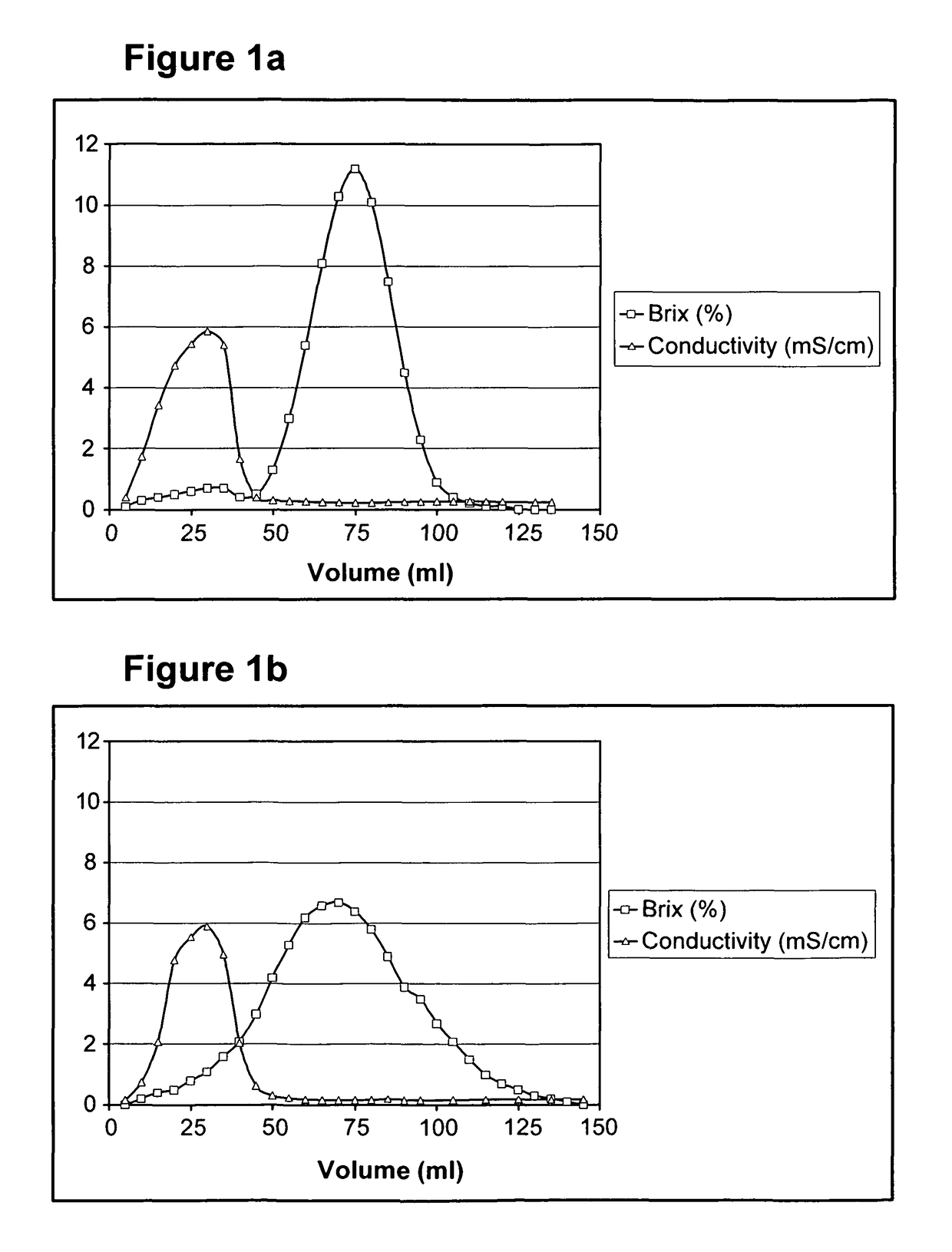Low-lactose and lactose-free milk product and process for production thereof
a technology applied in the field process for production thereof, can solve the problems of increasing waste water load, requiring further processing, and removing lactose, so as to reduce waste water load, simplify and enhance the production of low-lactose and lactose-free milk products, and avoid calcium and protein losses.
- Summary
- Abstract
- Description
- Claims
- Application Information
AI Technical Summary
Benefits of technology
Problems solved by technology
Method used
Image
Examples
example 1
ase Nanofiltration of Hydrolyzed Skim Milk with Desal 5 DL Membrane (K=3)
[0059]Skim milk (20 l) was hydrolyzed (9° C., 18 h) by Godo YNL2 lactase (Godo Shusei Company, Japan) with a dosage of 0.08% and nanofiltered with a Desal 5 DL membrane (GE Osmonics, USA) at a temperature of 10 to 18° C. and a pressure of 12 to 21 bar. The permeate flow was 5.7 to 9.6 l / m2h. The nanofiltration was continued until the concentration factor was 3 and the retentate volume 6.7 l and the permeate volume 13.3 l.
[0060]Samples were taken from the feed, which consisted of hydrolyzed skim milk, obtained NF retentate and NF permeate, and protein, dry matter, glucose, galactose, ash, and calcium were determined on the basis of the samples (table 1).
[0061]
TABLE 1Nanofiltration retentate and permeate compositionsFeed(hydrolyzedCompositionskim milk)NF retentate INF permeate IProtein (%)3.48.70.1Ash (%)0.81.50.2Calcium (mg / kg)1100300023Dry matter (%)8.819.61.9Glucose (%)2.34.40.9Galactose (%)2.24.50.8Ca / protein...
example 2
se Nanofiltration (Membrane Desal DK+Diafiltration and Membrane Filmtec NF) of Hydrolyzed Skim Milk Combined with RO Filtration
[0063]0.06% of Godo YNL2 lactase (Godo Shusei Company, Japan) was added into skim milk (20 l) and hydrolyzed for 18 h at 10° C. The residual lactose content of the skim milk was then 0.03%. The thus obtained hydrolyzed skim milk was nanofiltered at 10 to 15° C. The filtration membrane was Desal 5 DK (GE Osmonics, USA) and the pressure was 13 to 19 bar, the permeate flow being 8.4 to 10.5 l / m2h. The hydrolyzed skim milk was first filtered with a concentration factor 2, which means that an amount of 10 l of permeate altogether was removed from the apparatus. This was followed by diafiltration, i.e. diawater (5 l) was added to the NF retentate I (10 l) at the same speed at which NF permeate II was produced. The permeate from the first nanofiltration phase and the permeate obtained from the diafiltration were recovered and combined. The combined permeate fractio...
example 3
Nanofiltration (Membranes Desal 5 DL (K=3) and Filmtec NF (K=6)) of Hydrolyzed Skim Milk
[0071]The phased nanofiltration of lactose-hydrolyzed skim milk was tested by performing the first phase in warm conditions, and nanofiltering in the second phase the NF permeate I obtained in the first phase in cold conditions to recover the minerals.
[0072]As described above, skim milk (40 l) was hydrolyzed (9° C., 18 h) with Godo YNL2 lactase (Godo Shusei Company, Japan) with a dosage of 0.08%. The hydrolyzed skim milk was nanofiltered at a temperature of 47 to 51° C. The filtration membrane was Desal 5 DL (GE Osmonics, USA). The pressure was increased to keep the flow constant. During the experiment, the permeate flow was 8.1 to 9.6 l / m2h and the pressure 4 to 6.4 bar. The filtration was continued until the concentration factor was 3.
[0073]Samples were taken from the feed, retentate and permeate and protein, dry matter, glucose, galactose and ash and calcium were determined on the basis of the...
PUM
 Login to View More
Login to View More Abstract
Description
Claims
Application Information
 Login to View More
Login to View More - R&D
- Intellectual Property
- Life Sciences
- Materials
- Tech Scout
- Unparalleled Data Quality
- Higher Quality Content
- 60% Fewer Hallucinations
Browse by: Latest US Patents, China's latest patents, Technical Efficacy Thesaurus, Application Domain, Technology Topic, Popular Technical Reports.
© 2025 PatSnap. All rights reserved.Legal|Privacy policy|Modern Slavery Act Transparency Statement|Sitemap|About US| Contact US: help@patsnap.com


